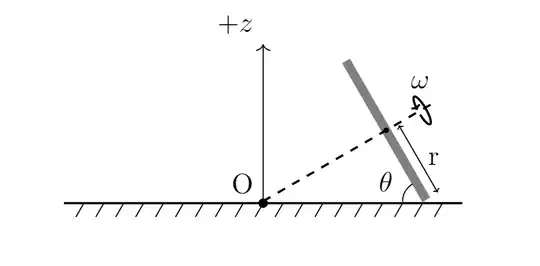First of all, an image to describe the situation we have:
Background
A uniform disc is rolling without slipping on a flat surface. The disc itself is also in circular motion about the point $O$. I have tried this with a roll of cellotape so the situation itself seems plausible. What I want to find is the radius of the disk in terms of $g$, $\omega$ and $\theta$.
My analysis
(apologies for the lack of any diagrams from here onwards)
Now, something must be keeping the disc from just falling over. If I take the angular momentum about the point of contact, I get $\overrightarrow{L}=\frac{3}{2}mr^2 \omega$. The vector itself is angled at $\frac{\pi}{2} - \theta$ to the floor, and is swinging around as the disk moves in space.
Some force is providing the torque for this to be possible. This force is the gravitational acceleration. There is no torque due to normal, frictional or centrifugal forces (?) about the point of contact. If we compute the torque due to gravity about the point of contact, we get $\overrightarrow{\tau} = mgr \cos{\theta}$.
The angular momentum vector is rotating about an axis perpendicular to it and inclined at $\frac{\pi}{2} - \theta$ to $+z$. Let us call the angular velocity about this axis $\Omega$. We can find $\Omega$ by picking the center of mass of the disc to study. The distance from $O$ to the COM is $r\tan{\theta}$. So we have $\Omega r\tan{\theta} = \omega r$, therefore $\Omega = \omega \cot{\theta}$.
Therefore, we can find the required torque to be $\overrightarrow{\tau}_{req} = L \Omega$. Equating $\overrightarrow{\tau}_{req}$ and $\overrightarrow{\tau}$, we get $$r = \frac{2g \sin{\theta}}{3 \omega^2}$$
Can someone please check my analysis? Since I came up with this myself, I don't have anything to refer to. (I also feel a little unsure whether centrifugal force has any role here.)
